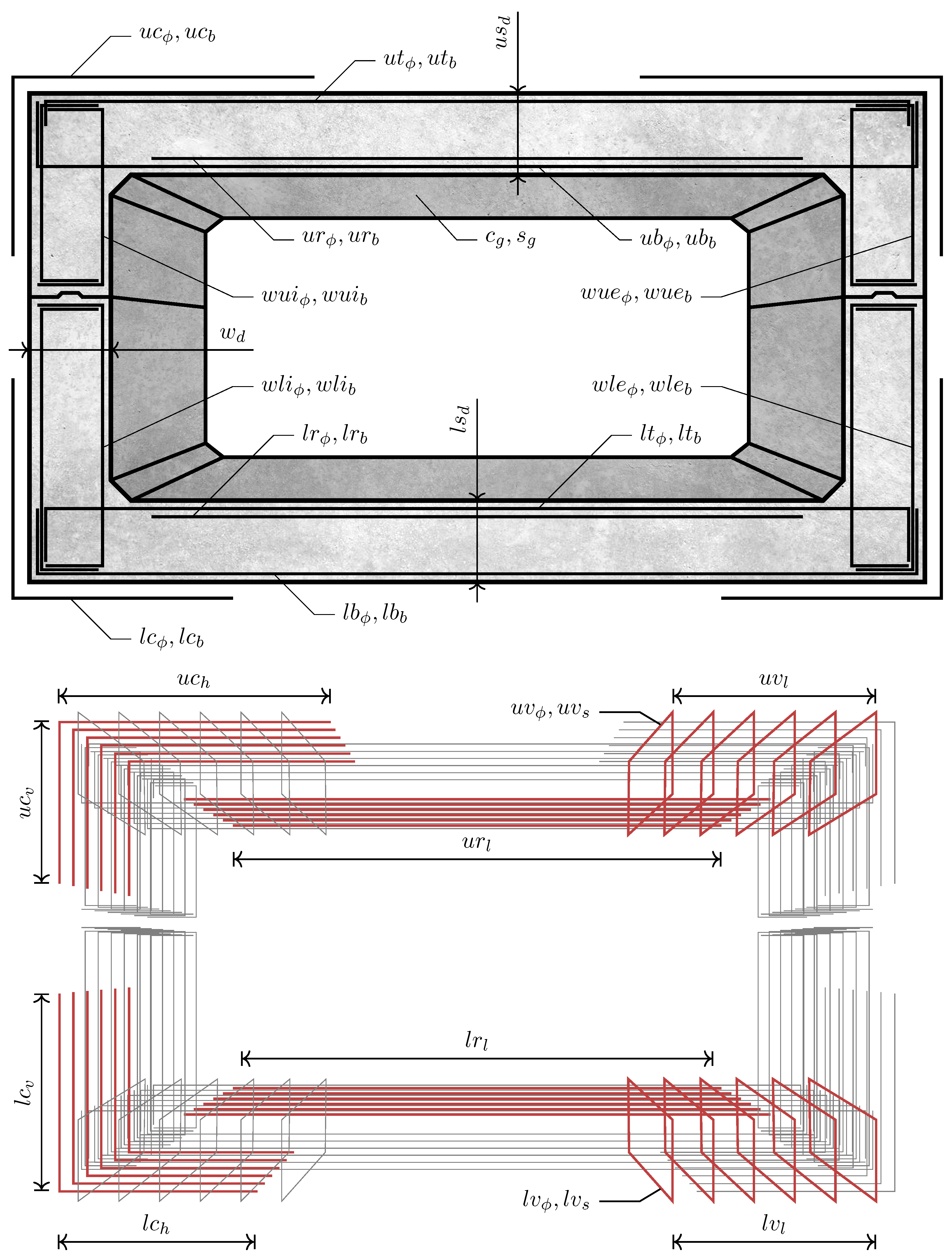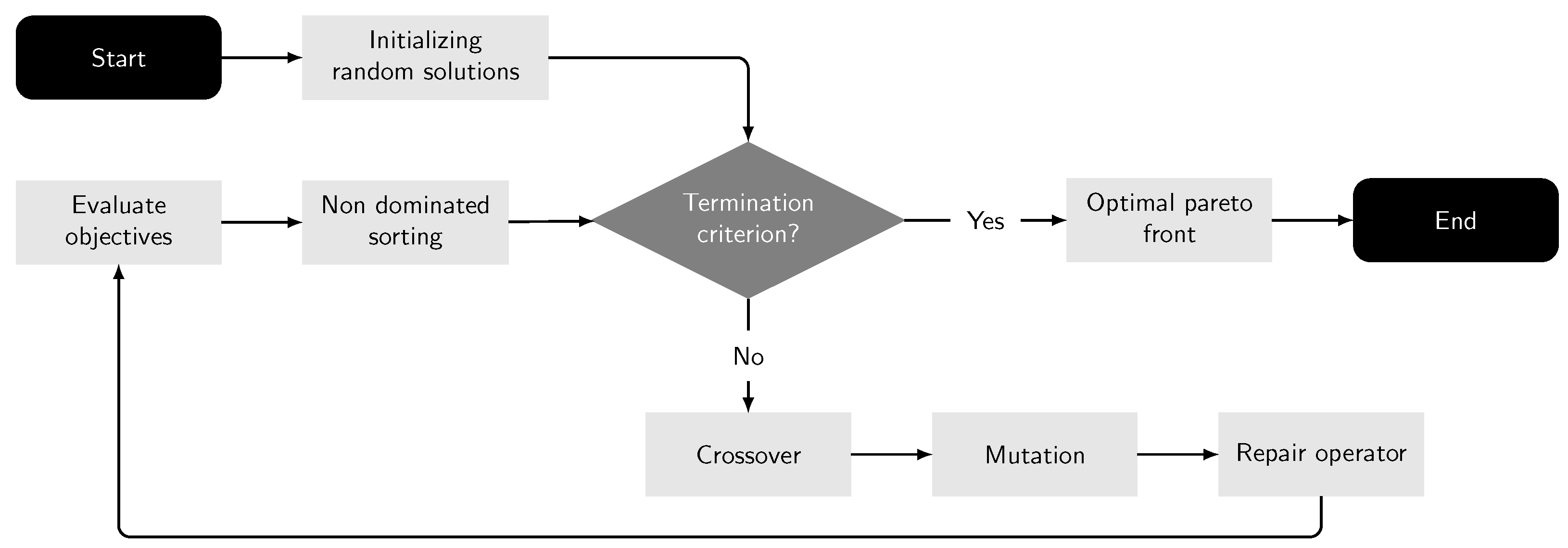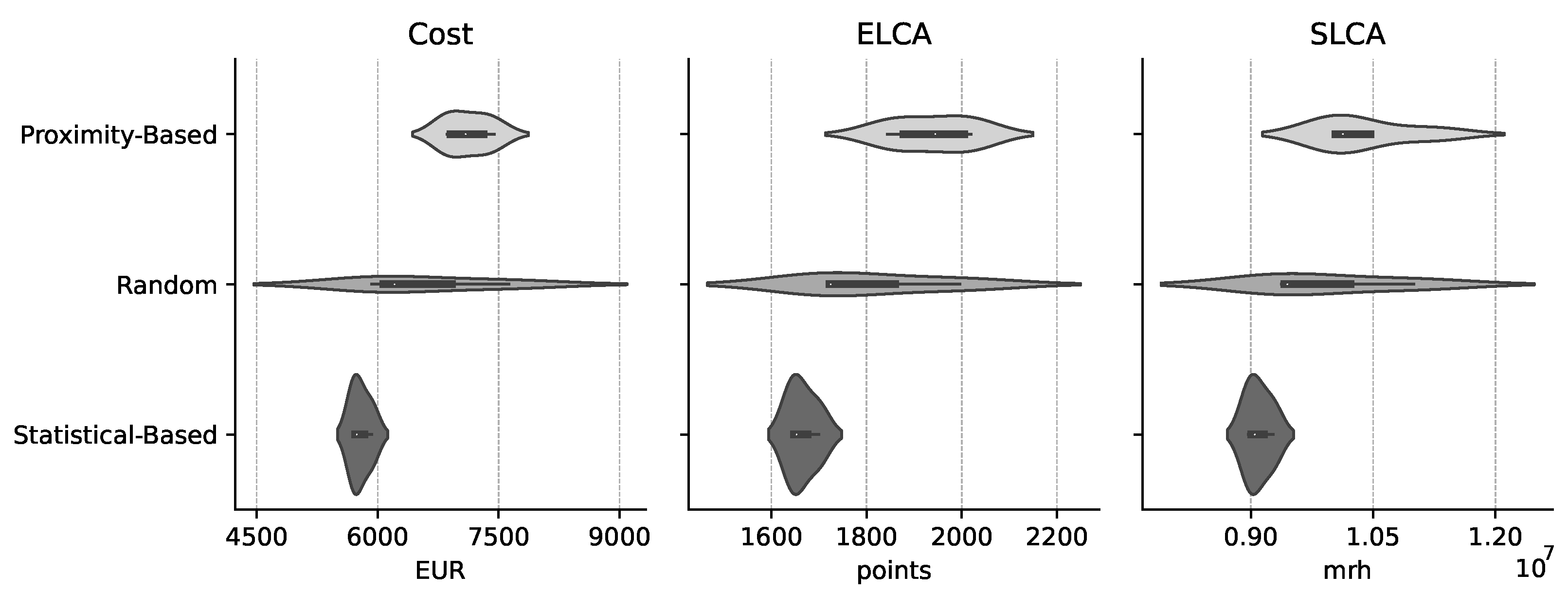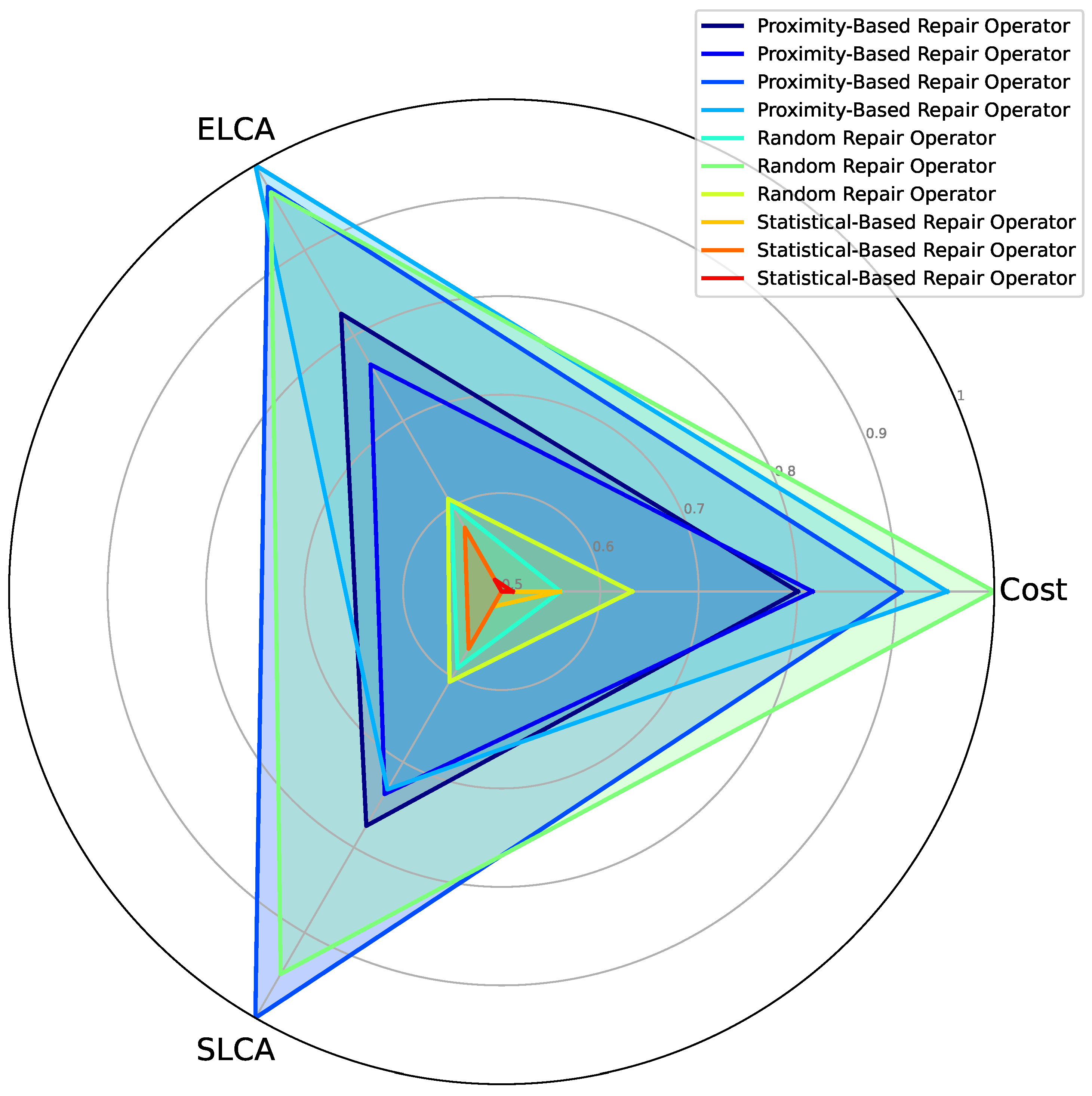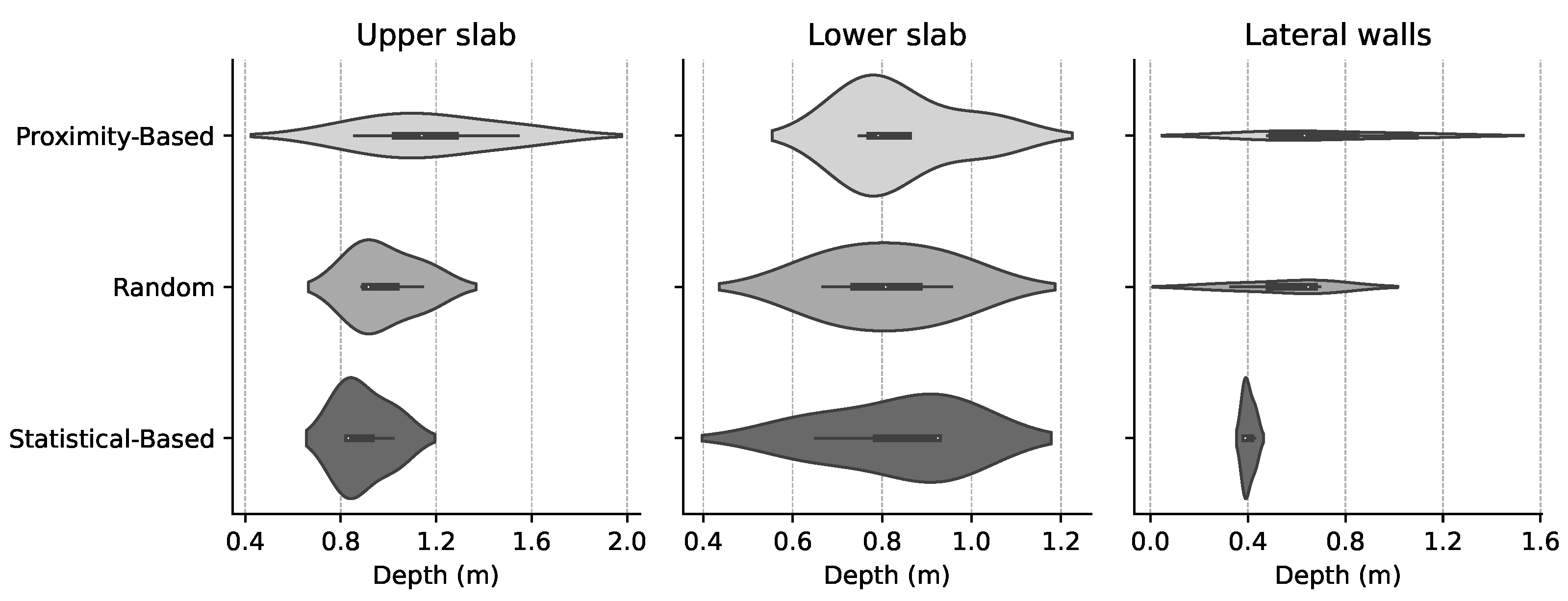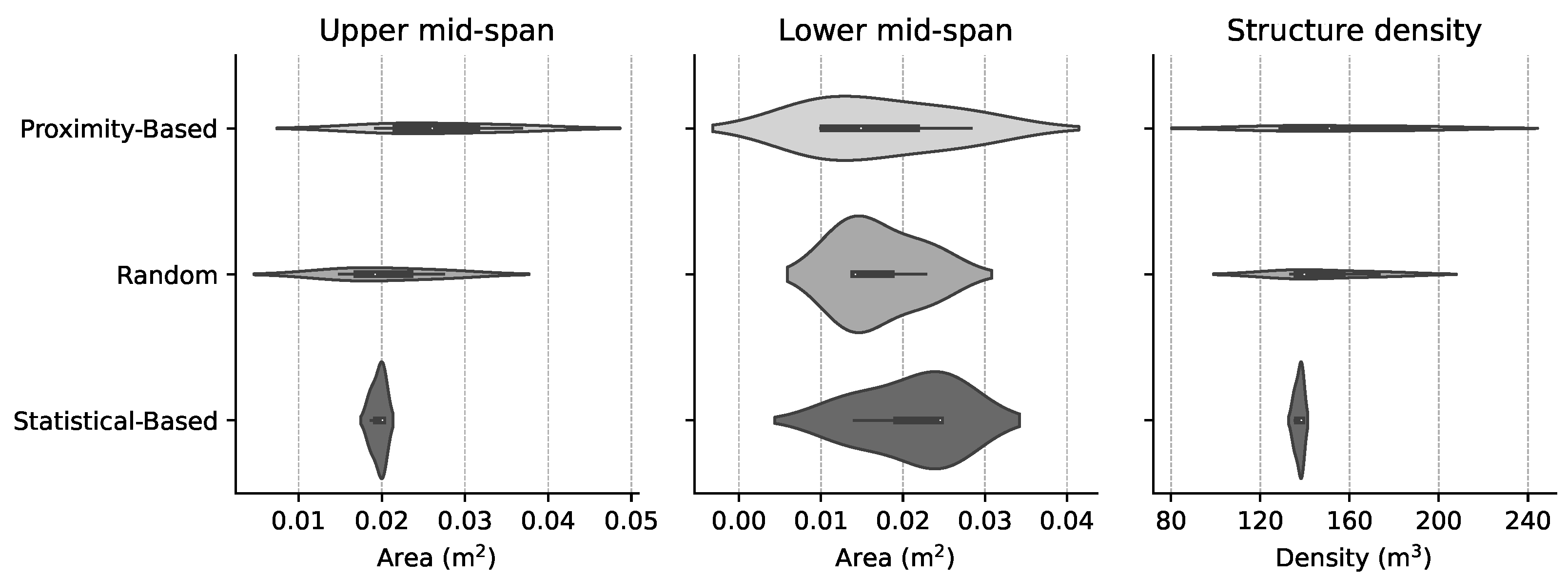This section provides a comprehensive overview of the RCPMF problem and delineates the NSGA-II algorithm as the selected MOO strategy. Furthermore, it delves into the entropy theory-based weighting method and the MCDM approaches, specifically delineating the SAW and FUCA techniques employed to assess the optimal solutions derived from the MOO process.
2.1. Optimization Problem Overview
MOO involves identifying a vector
, comprising
n variables, that minimizes
k objective functions while adhering to
m constraints. Equations (
1) through (
3) delineate the foundational structure for a generic MOO problem.
The optimization problem of this research consists of the design of a RCPMF. The specified structure extends 10 m horizontally, has a height of 5 m, and is buried to a depth of 5 m.
Section 2.1.1 and
Section 2.1.2 detail the variables, parameters, and constraints integral to the RCPMF problem. Adopting a comprehensive MOO approach, this study integrates the three pillars of sustainability: the economic cost of the structure, the ELCA endpoint single score, and the SLCA endpoint score. These elements, elaborated on in
Section 2.1.3, are the objective functions earmarked for minimization.
2.1.1. Variables and Parameters
The RCPMF problem, illustrated in
Figure 1, encompasses 41 design variables, broadening the scope beyond previous studies focused on the final cost minimization via SOO [
16]. Among these variables, three relate to the geometry of the lateral walls and the upper and lower slabs (
). Multiple variables are allocated to the configurations of passive reinforcement in all structural sections. This comprehensive set includes corner reinforcement (
) and bending reinforcement in the central sections of the top and bottom slabs (
). The remaining variables are critical in defining the positioning and configuration of shear reinforcement and determining structural concrete and steel material grades (
).
The MIP nature of the problem requires establishing upper and lower bounds for three distinct categories of variables: choice (discrete), integer, and real (continuous).
Each category undergoes unique processing during the optimization phase via custom-developed repair operators. These operators are designed explicitly for mutation, crossover, and repair functions within the NSGA-II optimization algorithm.
Table 1 comprehensively details the set of optimization variables, categorizing them by type and specifying their respective upper and lower bounds.
In addition to the optimization variables, the structural design problem encompasses a comprehensive set of parameters that remain constant throughout the optimization process. In conjunction with the previously delineated optimization variables, these parameters enable the complete characterization of the RCPMF design. The problem incorporates parameters relevant to the structure’s geometry and those necessary for calculating structural loads. Moreover, it includes several parameters necessary for evaluating the objective functions. These encompass the economic cost of materials and the environmental and social impacts, which are assessed over the structure’s life cycle.
Table 2 summarizes the main optimization parameters of the problem along with their specific values.
2.1.2. Constraints
The constraints of the RCPMF problem ensure the representativeness of the mathematical model. Structural solutions generated during the optimization process are required to conform to the ultimate limit states (ULS) and service limit states (SLS) as stipulated in the applicable regulations [
22,
23]. Furthermore, the designs adhere to specific guidelines and recommendations for buried structures [
24,
25].
The ULS ensure the structural integrity of all sections under diverse loading scenarios. Compliance with ULS involves a multi-step verification process [
15]. Initially, it requires verifying sectional shear stress resistance [
26], followed by assessing normal stresses via N-M interaction diagrams. This procedure includes accounting for the increase in bending moments due to shear interaction. Subsequent steps include confirming the fatigue resistance of the structure and evaluating additional geometrical and reinforcement design characteristics, which are closely linked to sectional properties.
The SLS criteria focus on maintaining the structure’s aesthetic integrity by preventing the generation and propagation of cracks. Additionally, SLS involves the restriction of deformations. Thus, global structure deflections in the upper slab central sections are assessed to remain within predefined allowable limits [
24].
Structural calculation and compliance verification are conducted using a mathematical model developed in Python 3 [
27]. This approach incorporates global models for calculating sectional internal forces, utilizing a finite element analysis (FEA) methodology [
28]. Additionally, local models for each structural section are computed and thoroughly evaluated to confirm compliance with the specified constraints [
22,
23]. The NSGA-II optimization algorithm from the pymoo library is modified and utilized to solve the MOO [
29]. During this process, the mathematical model generates a constraint vector adapted to its functional requirements for each solution.
2.1.3. Objective Functions
Three objective functions are established for an integrated approach to enhancing RCPMF sustainability performance. Equations (
4), (
6), and (
7), evaluate the economic cost, the ELCA endpoint, and the SLCA endpoint of the structure life cycle, respectively. The Python numerical model integrates all necessary calculations for evaluating these objective functions and generates a vector representing specific values for each solution throughout the optimization process.
The final cost of the structure is determined by summing the products of the material unit costs,
, and the specific quantities of materials used,
. The unit values in this study, detailed in
Table 3, were sourced from the BEDEC database [
30].
The life cycle of the RCPMF encompasses all processes from raw material extraction to the post-service life disposal of the structure’s remains, while treating the life cycle assessment (LCA) calculation as a “black box” executed externally by OpenLCA 2.1 software is a feasible method [
31], this study opts to develop a numerical model that utilizes the precomputed individual impacts of each process.
The life cycle model, depicted in
Figure 2, adheres to the ISO 14040:2006 standard, including four stages: manufacture, construction, use, and end-of-life [
19].
Table 4 details each process’s unit environmental and social impacts. The data is sourced from the ecoinvent 3.7.1 and soca v2 databases [
32,
33,
34] and evaluated employing the ReCiPe 2008 and SWIM life cycle impact assessment (LCIA) methods for environmental and social impacts, respectively, [
35].
The manufacturing stage covers all processes, from the extraction of raw materials to the delivery of ready-to-use materials to the construction site. The construction phase includes site preparation, earth moving, transportation, assembling the structural components, covering the structure, and installing auxiliary systems. The use phase models routine minor repairs to the internal surface of the structure and the associated impact of traffic diversions due to these activities. Lastly, the end-of-life stage encompasses unearthing, dismantling the structure and transporting materials to recycling facilities and landfills.
Concrete acts as a carbon-sequestering component. The carbon dioxide captured through the carbonation process during the structure’s use and end-of-life stages is estimated using Fick’s law, detailed in Equation (
5). Here,
t represents the 100-year service life of the structure,
k the carbonation coefficient,
A the area affected by carbonation,
C the amount of cement, and
K the clinker content. The optimization problem incorporates parameters such as the carbonation coefficients for the interior and exterior walls, the quantity of cement, and the clinker content. The area affected by carbonation is calculated by integrating the geometric optimization variables of the RCPMF.
By integrating all the considerations above, the endpoint results for the ELCA and SLCA are computed as the cumulative sum of the products of the environmental impact factors,
, or social impact factors,
, and the quantity of the process
required throughout the
j stages of the structure’s life cycle.
2.2. Optimization Algorithm
This section aims to delineate the NSGA-II, [
18], the MOO algorithm employed for optimizing the RCPMF structure. Initially, a comprehensive elucidation of the standard NSGA-II algorithm will be presented. Subsequently, the next section will introduce specialized repair operators tailored for addressing the unique challenges posed by the mixed-integer optimization problem, which amalgamates discrete, integer, and continuous variables. This dual-phase approach facilitates a profound understanding of the algorithm’s core mechanics before delving into the customized modifications necessary for the specific optimization task at hand.
Figure 3 presents a flowchart that encapsulates the algorithm’s proposed framework, illustrating the integrated process introduced in our study.
NSGA-II is a methodical, iterative process leveraging a population-based approach. It draws upon the principles of natural selection and genetics to evolve solutions towards an optimal set of trade-offs, known as the Pareto front. Central to NSGA-II is its non-dominated sorting mechanism, which stratifies the population into various levels of Pareto fronts based on dominance criteria. A solution is deemed to dominate another if it is equally competent in all objectives and superior in at least one. The foremost front comprises solutions not dominated by any others in the population, with subsequent fronts determined in a similar fashion.
Another critical element of NSGA-II is the crowding distance assignment. This metric gauges solution density within the objective space, ensuring diversity among solutions and averting premature convergence to localized Pareto front regions. It aids in maintaining a comprehensive spread of solutions across the entire range of trade-offs. Genetic operators in NSGA-II, namely selection, crossover, and mutation, play pivotal roles. Selection processes prefer solutions from lower Pareto fronts and those with greater crowding distances, promoting the caliber and diversity of solutions. Crossover and mutation introduce novel variations and traits into the population, encouraging a thorough exploration of the solution space.
The iterative nature of NSGA-II involves cultivating a new population (offspring) from the existing one via these genetic operators. The amalgamated population of parents and offspring is then subjected to non-dominated sorting and crowding distance evaluation. The top-tier solutions are cherry-picked to constitute the next generation, preserving a constant population size. The efficacy of NSGA-II is manifest in its adeptness at unearthing a diverse array of high-caliber trade-off solutions, rendering it apt for complex multi-objective quandaries. Its utility spans diverse domains, ranging from engineering design to resource management, where decisions necessitate juggling conflicting objectives.
In this particular study, additional configurations were implemented for crossover, mutation, and repair operators, which will be explicated in the following section.
2.3. Solution Crossover, Mutation, and Repair Algorithms
In this study, the crossover operation was implemented using a Simulated Binary Crossover (SBX) operator, while mutations were introduced via a Polynomial Mutation (PM) operator. Additionally, three distinct repair operators were integrated: one based on proximity, another employing random modifications, and a third leveraging statistical concepts of mean and median for solution adjustments.
Simulated binary crossover (SBX): The SBX operator, a nuanced crossover technique, emulates the single-point crossover observed in binary strings, but is adapted for real-coded genetic algorithms. It excels in generating offspring solutions proximate to their parent solutions, thereby enabling a detailed search in the immediate solution space. The offspring distribution’s breadth is modulated by a distribution index parameter, which determines the offspring’s spread relative to their parents. A lower index promotes exploration by creating offspring further from the parent solutions, while a higher index encourages exploitation by generating offspring closer to the parent solutions.
Polynomial mutation (PM): The PM operator, designed for real-valued representations, introduces variability by subtly modifying a solution’s variable values. Governed by a distribution index, this mutation process mirrors the bit-wise mutation in binary-coded genetic algorithms, yet it is specifically tailored for continuous variable contexts. PM plays a vital role in maintaining diversity within the population and averting premature convergence, particularly in scenarios involving continuous or real-valued parameters.
Proximity-based repair operator: The proximity-based repair operator is an approach designed to rectify solutions that do not adhere to the constraints of an optimization problem, Algorithm 1. This operator is particularly effective in contexts where solutions involve a mix of discrete, integer, and continuous variables. The core principle of this operator lies in its ability to adjust each variable of a solution by selecting values that are closest to the original, yet still within the permissible range defined by the problem’s constraints.
| Algorithm 1 Proximity-Based Repair Operator |
- 1:
Function Repair(X) - 2:
Input: X - 3:
Output: - 4:
copy of X - 5:
for each solution x in do - 6:
for each variable index j in x do - 7:
variable type at index j - 8:
if is Choice then - 9:
value closest to in - 10:
else if is Integer then - 11:
round to nearest integer within - 12:
else if is Real then - 13:
clip within - 14:
end if - 15:
end for - 16:
end for - 17:
return
|
For each variable in a solution, the operator evaluates its type–whether it is a choice (discrete), integer, or real (continuous). Based on the type, the operator performs the following actions:
Choice variables: The operator selects the option from the predefined set that is closest to the current value of the variable.
Integer variables: The operator rounds the variable to the nearest integer that falls within the defined bounds, ensuring that the solution remains feasible.
Real variables: The operator clips the variable’s value to ensure it lies within the allowable continuous range.
Statistical-based repair operator: The statistical-based repair operator, Algorithm 2, ingeniously integrates statistical measures–mean and median–with a probabilistic approach to refine solutions in an optimization algorithm. This operator, in each iteration, processes every solution and employs a probability parameter
to determine the repair strategy. If the random number generated is less than
, the operator uses median for discrete variables (Choice and Integer) and mean for continuous (Real) variables. The median is particularly beneficial for discrete variables, offering robustness against outliers and reflecting the most common values in the population. Conversely, the mean provides an average value for continuous variables, encapsulating the central tendency of the population.
| Algorithm 2 Statistical-Based Repair Operator |
- 1:
Function StatisticalRepair(X, ) - 2:
Input: X, - 3:
Output: - 4:
copy of X - 5:
mean of X along axis 0 - 6:
median of X along axis 0 - 7:
for each solution x in do - 8:
for each variable index j in x do - 9:
variable type at index j - 10:
if then - 11:
if is Choice or Integer then - 12:
medians[j] - 13:
if is Choice then - 14:
closest value to in - 15:
else - 16:
round to nearest integer within - 17:
end if - 18:
end if is Real then - 19:
clip means[j] within - 20:
end if - 21:
else - 22:
Apply standard repair based on variable type and bounds - 23:
end if - 24:
end for - 25:
end for - 26:
return
|
Random repair operator: The random repair operator, Algorithm 3, is designed to introduce randomness into the solution repair process, which is essential for enhancing diversity in the solution space. It operates by iterating over each solution in the population and randomly assigning new values to the variables based on their type. For choice variables, a random option is selected from the available choices. Integer variables are assigned a random integer within their bounds, and real variables receive a random value within their defined range. This randomness helps in exploring uncharted areas of the solution space, thereby preventing the algorithm from stagnating at local optima and encouraging a more thorough exploration.
| Algorithm 3 Random Repair Operator |
- 1:
Function RandomRepair(X) - 2:
Input: X - 3:
Output: - 4:
copy of X - 5:
for each solution x in do - 6:
for each variable index j in x do - 7:
variable type at index j - 8:
if is Choice then - 9:
random choice from - 10:
else if is Integer then - 11:
random integer within - 12:
else if is Real then - 13:
random real number within - 14:
end if - 15:
end for - 16:
end for - 17:
return
|
2.4. Evaluation and Decision-Making Methods
The result of the MOO conducted in this study is a set of RCPMFs that balance the minimization of the objective functions. These solutions are evaluated by aggregating and comparing the influence of relevant structural characteristics on the economic cost, ELCA and SLCA scores for each repair operator. This analysis aims to identify common trends in the optimal solution set and derive directly applicable, improvement-oriented design approaches.
Decision-making within transportation infrastructure projects is fundamentally intricate. Influences outside the purview of this research, including local regulations and specific project mandates, frequently affect the identification of optimal solutions in civil engineering. This study provides a framework for integrating sustainability’s multifaceted dimensions into the optimal structural design, aiming for a more informed decision-making process. This approach aligns well-defined MOO objectives with relevant criteria for MCDM. Despite the inherent complexity, integrating these aspects into a well-informed decision-making framework is essential for fostering the construction industry’s long-term sustainability.
Utilizing MCDM techniques introduces several advantageous elements to complex engineering decision-making processes. Sustainable construction requires the equilibrium of intricate economic, environmental, and social criteria. The diverse stakeholders involved in the life cycle of an infrastructure project often have different criteria with conflicting and competing natures. Within this framework, harmonizing the criteria of the MCDM problem with the objectives of the MOO problem, as delineated in this study, offers a pathway to enhance the decision-making process in sustainable construction.
This research addresses a MCDM problem, represented by a decision matrix
consisting of
m alternatives and
n criteria, denoted as
. The element
of the decision matrix
X provides insight into the performance of the alternative
i concerning criterion
j. Weighting the multiple criteria is a crucial step in resolving the MCDM problem. The research employs an entropy-based method to calculate the
criteria weights, [
21].
The entropy-based weighting approach utilized in this research objectively calculates the weight of each criterion according to its variability among the alternatives. This methodology leverages the intrinsic uncertainty or randomness linked with entropy to eliminate subjectivity in the weighting process, with criteria deemed to offer more information to the decision-making process receiving higher weighting. Moreover, it fosters transparent and inclusive decision-making when applied to sustainability criteria.
The criteria weights are computed through a four-step process. The first step involves normalizing the decision matrix, as described in Equation (
8), resulting in
, the normalized decision matrix.
In the second step, the entropy of each criterion
is calculated using Equation (
9). A higher entropy value indicates greater variability across the
i alternatives for criterion
j. In this step is assumed that, if
, then the corresponding natural logarithm is null.
The third step is dedicated to assessing the variation of each criterion through Equation (
10). This evaluation yields the degree of divergence
for each criterion
j.
Finally, the fourth step involves normalizing the
, as delineated in Equation (
11), resulting in the final criteria weights
.
The subsequent phase in the decision-making process involves applying an algorithm to address the MCDM problem. The research employed the SAW and FUCA algorithms to resolve the optimum selection problem.
Numerous researchers in the construction sector employ SAW for decision-making involving structural sustainability [
36]. This approach, rooted in complexity-based classification, facilitates the evaluation of solutions through a well-established objective and transparent method. Implementing the SAW algorithm within this study involves three distinct steps. The process begins by calculating the normalized decision matrix
.
The second step calculates the
scores for each alternative, employing Equation (
12). The scores result from aggregating the weighted normalized performance of each alternative across all criteria.
In the third and concluding step, the values determine the ranking of the alternatives, providing a systematic framework for identifying the most sustainable options.
The second decision-making algorithm chosen to address the MCDM problem is the FUCA [
20], while having an approach and algorithmic structure similar to the SAW, this technique has operational differences that could lead to differing outcomes. A significant challenge in solving engineering MCDM problems lies in selecting suitable and effective techniques, which can evolve into a complex decision-making problem. The study conducts a comparative analysis within this framework between the established SAW method and the FUCA approach. This comparison aims to evaluate the feasibility and applicability of the FUCA technique in construction engineering decision-making, highlighting its potential advantages and differences in outcomes.
The FUCA algorithm is executed in three stages. In the first step, the solutions are ranked according to each criterion. The second step involves calculating the scores of the alternatives through Equation (
13), where
denotes the rank of
m solutions across
n criteria.
The third and final step of the FUCA algorithm employed in this research is ranking the alternatives according to previously computed values.
The criteria weighting procedure and the MCDM techniques outlined in this section provide a methodical strategy for managing complex engineering decision-making problems. This structured approach provides decision-makers with a framework for informed and transparent choices.
